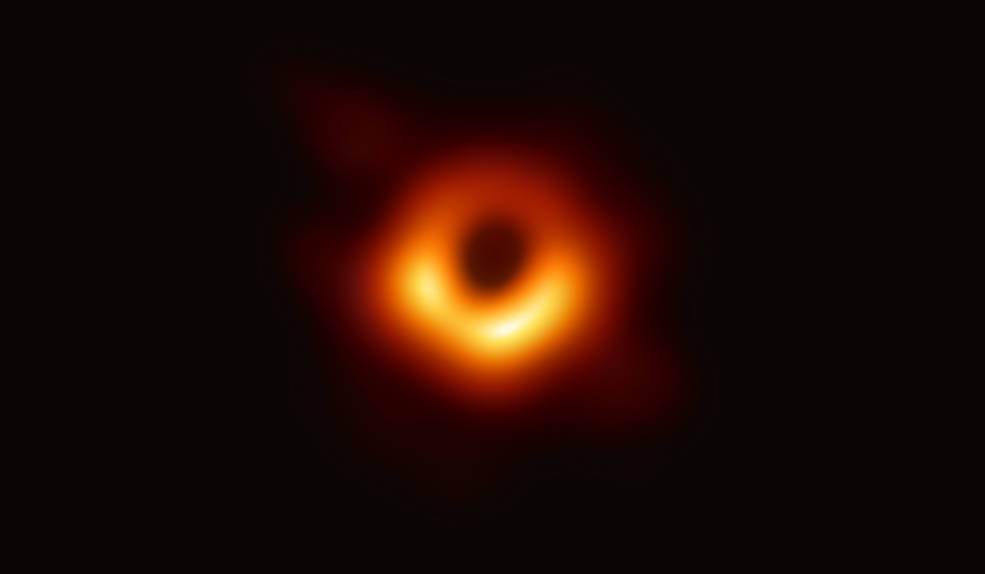First Black Hole Image
-- posted October 2020 --
In 2019, a global team of researchers created the first-ever image of a black hole. Like in the popular joke ‘How many people does it take to do X,’ how many researchers do you think it took to create that first image of a black hole? The answer is 347 researchers (a subgroup of the team is shown below), which speaks volumes of the challenges, required expertise, and efforts to produce the image.


We will get to the image in a moment, but first, the very term ‘black hole’ is a little misleading. ‘Hole’ implies an empty area, void of any matter. On the opposite, ‘black holes’ are large and very dense astronomical bodies, often many times larger than the Sun. Even light cannot escape the gravitational field of such bodies, and as a result, they appear black and invisible to our telescopes. Until recently, the existence of black holes was just a theoretical hypothesis outlined in the General Theory of Relativity (by Albert Einstein, of course).
We know from Physics classes that all physical objects have a gravitational attraction field. Recall the famous story when Isaac Newton observed an apple falling from the tree and came to the revolutionary revelation that it was due to the gravitational force of the Earth. The Earth pulls all objects toward its center, and for instance, for a spacecraft or any other object to break free of Earth’s gravity, it needs to achieve a velocity of at least 7 miles/s (11 km/s). This is known as Earth escape velocity. For the same spacecraft to leave the planet Jupiter that has 320 times the mass of Earth, it needs to achieve escape velocity of at least 37 miles/s (60 km/s). Understandably, the larger the celestial body, the larger the velocity other objects need to attain, in order to overcome their gravitational field.
For an extremely large body, the escape velocity may exceed the speed of light (approximately 186,000 miles/s or 300,000 km/s), meaning that light is trapped and cannot escape the body. That is exactly what black holes are: objects with large mass densely concentrated in a small spatial area, having an enormous gravitational force that does not allow light to leave it. The boundary (or, the surface of the sphere) of a black hole is known as event horizon, whereas the center of the black hole is referred to as a gravitational singularity.
Although we cannot see or detect black holes with telescopes, the strong gravity affects their surroundings and attracts intergalactic debris, dust, and other stars and planets. By observing the interaction with matter and electromagnetic radiation (light) around a seemingly empty region, in combination with very high temperatures in that region, astronomers can presume the existence of a black hole.
This particular black hole in the image is in the center of the galaxy called M87, located about 55 million light-years from us. It is a supermassive black hole having 6.5 billion times the mass of our Sun! Since M87 galaxy is so far, to be able to capture it, the scientists tried to simulate a telescope of the size of the Earth, by simultaneously taking images from eight telescopes located at different locations (e.g., Antarctica, Chile, Mexico, Hawaii, Arizona, Spain), and stitching those images together into several final images. The image of the black hole looks blurry due to the distance to it. But then, the question is, why there is light around the black hole in the image? Informally, as the black hole warps the space-time continuum, a portion of light rays that approaches the black hole orbits around it: that is the visible ring of light in the image.
Having knowledge about black holes is very important for our understanding of the universe. For instance, if we know the approximate size and mass of black holes in the universe, we can develop more accurate theories of the movements and orbits of galaxies, obtain better estimates of the rate of expansion of the universe, and resolve other related open questions. Scientists believe that supermassive black holes exist in the centers of most galaxies (as well as in the center of our Milky Way). This first image of a black hole is a significant small step toward unveiling the mysteries of the universe.
A 5:28 minute video explaining the capturing of the black hole image can be found here:
https://www.youtube.com/watch?v=S_GVbuddri8
